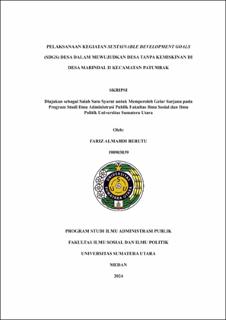Pelaksanaan Kegiatan Sustainable Development Goals (SDGS) Desa dalam Mewujudkan Desa Tanpa Kemiskinan di Desa Marindal II Kecamatan Patumbak
Implementation of Village Sustainable Development Goals (SDGS) Activities in Realizing Villages Without Poverty in Marindal II Village, Patumbak Sub-District

Date
2024Author
Berutu, Fariz Almahdi
Advisor(s)
Thamrin, Muhammad Husni
Metadata
Show full item recordAbstract
Poverty in rural areas is still a serious problem faced by Indonesia today.
The existence of Village SDGs, which is a derivative of the global SDGs, is a
solution in overcoming poverty problems. The implementation of Village SDGs
activities in Marindal II Village in overcoming the problem of poverty is still
insufficient. In 2021, the number of poor people in Marindal II Village reached
2110 and is one o f the villages in Patumbak Sub district that has the most poor
people. In the Village SDGs assessment, Marindal II Village has a score of 45.28
and is in third place with the highest Village SDGs score in Patumbak Sub
district. However, in goal number 1 (V illages without Poverty), Marindal II
Village only scored 59.36 and was the Village with the lowest score in Patumbak
Sub district. This research aims to examine and describe in depth how the
implementation of the Village Sustainable Development Goals (SDG s) in realizing
a Village without poverty in Marindal II Village, Patumbak District.
The method used in this research is descriptive research with a qualitative
approach. Data collection was carried out by observation, interviews,
documentation and literature. The data obtained was analyzed qualitatively using
implementation indicators fro m George C. Edward III which consists of four
indicators, namely communication, resources, disposition or attitude of
implementers and bureaucratic structure.
The results showed that the communication carried out by the Marindal II
Village Government to t he community was not good enough. This is indicated by
the absence of socialization related to Village SDGs to the community. The
resource indicators have gone well, although there are budget constraints in
overcoming poverty, the Village Government can ma nage the existing budget
well. The disposition indicator has been running well through the provision of
good services to the community. Finally, the bureaucratic structure indicator is
quite good, characterized by the commitment and coordination of the pol icy
implementers. In addition, the village data collection is still not good enough,
indicated by the distribution of household questionnaires which still reaches
15.70%. Therefore, several existing obstacles must be addressed so that the first
Village SDG s goal, namely Villages without poverty, can be truly realized
Collections
- Undergraduate Theses [1938]
